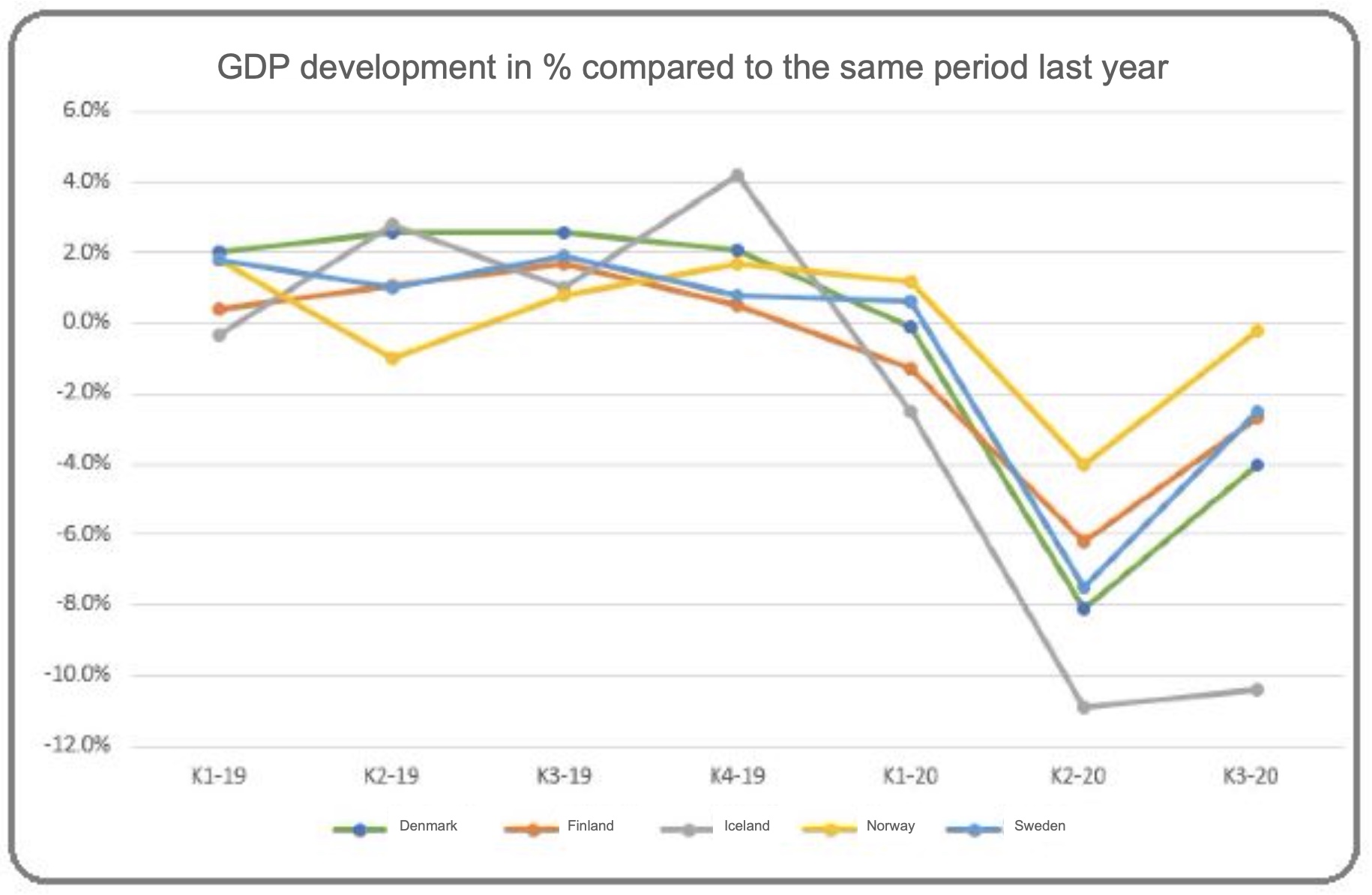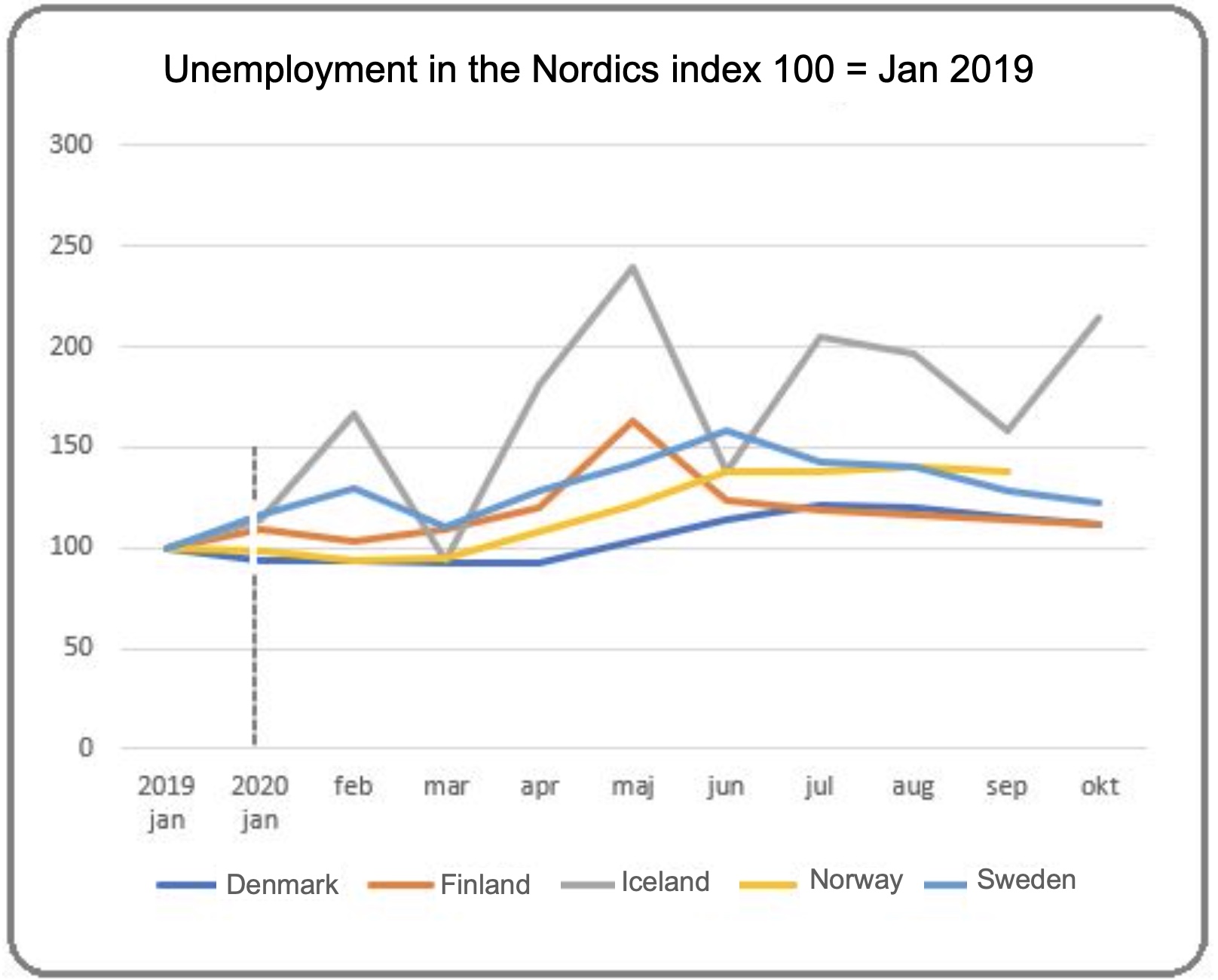How have the Nordics managed the Corona crisis so far?
The Nordic countries have dealt with the economic crisis caused by the Corona pandemic in similar ways. As a result, unemployment is now falling back to more normal levels. A report from the Danish Technological Institute on commission from the Nordic Council of Ministers argues it is time to adjust the support measures.
When the Corona pandemic was declared by the WHO on 11 March 2020, stock markets fell by one third according to the leading US stock market index. Unemployment rose sharply. The crisis can be compared to the 1929 stock market crash which preceded the Great Depression of the 1930s, the oil crisis in the 1970s and the financial crisis which began in 2008. But there is one big difference.
“The Corona crisis was not a result of the economy per se, but of an unforeseeable external event – a pandemic. You could describe is as a kind of natural disaster, and it is being fought with wide-ranging infection controls that dampen economic activity,” write Martin Eggert Hansen, Stig Yding Sørensen and Tine Andersen. 
The Nordic countries saw a dramatic fall in their GDPs after the pandemic struck in March 2020. Iceland was the hardest hit while Norway almost achieved positive growth in the third quarter of 2020. Source: Eurostat/Danish Technological Institute
A “normal” crisis has certain patterns which to some extent can be predicted using economic models. But the Corona crisis has a far more unpredictable time horizon and spread. The crucial factor is human behaviour and this can only be partially controlled by political action. While traditional crises hit society in a broad sense, the Corona crisis is selective. It mainly hits trades where workers have a lot of contact with other people, like tourism and retail.
Fewer measures in Sweden
Sweden stood out among the Nordics by introducing relatively minor measures. Restrictions were based on recommendations and voluntary action. This was not based on economic considerations. The Public Health Agency of Sweden made the decision without much political input, the report points out.
“Even if the Swedish restrictions were mild and based on voluntary action, they have put a strong damper on the economy. Restaurants lost 70% of their revenue from the middle of March 2020, and clothes shops saw a 50% drop from that same date,” says Martin Eggert Hansen.
Unemployment rose rapidly in all of the Nordic countries. The exceptions are the autonomous regions of Greenland and the Faroe Islands, which have so far not seen a single death from Corona.
 The researchers have created a graph using index numbers to show unemployment in the Nordic countries. They put January 2019 as 100. We have compressed what happened in 2019 and then show the monthly development. The peak for unemployment came in May – June and has since fallen everywhere except in Iceland. Source: Eurostat, Technological Institute.
The researchers have created a graph using index numbers to show unemployment in the Nordic countries. They put January 2019 as 100. We have compressed what happened in 2019 and then show the monthly development. The peak for unemployment came in May – June and has since fallen everywhere except in Iceland. Source: Eurostat, Technological Institute.
Young people were hardest hit by the rise in unemployment in all of the Nordic countries except Norway. This group often works in trades that are harder hit by Corona, like tourism, hospitality and retail. Young people also have less work experience and a looser connection to the labour market than older people, and are more likely to be on time-limited or temporary contracts.

The graph shows the average change to unemployment between April and June 2020 compared to the same period in 2019. Young people are aged 15 to 24, older people are aged 25 to 74. The difference is most pronounced in Iceland, where unemployment among young people has risen by 42%. Older people, however, have seen a fall in unemployment. In Norway, older workers have been the hardest hit. Source: LFS National statistics.
There are smaller differences between genders, social groups and immigrants compared to the rest of the population, and statistics are fewer. Not surprisingly, immigrant groups are harder hit than other groups – in particular those with lower education from non-Western countries.
The researchers found the largest differences, both within and between countries, when looking at different trades. Below, we have chosen 6 out of the 19 trades which the researchers compared to see how employment changed in the second quarter of 2020, compared to the same period in 2019:

While employment in agriculture and fisheries fell in Denmark, Finland and Iceland, it rose somewhat in Norway and Sweden. The hospitality sector has seen a steep drop in employment across those three countries, while in Iceland and Norway it has been less dramatic.
The construction industry, public administration and the health sector have seen the smallest rise in unemployment. It appears that Denmark, Iceland and Norway have provided more support to the cultural sector than Finland and Sweden.
It is difficult to determine which countries have managed the crisis the best, due to the varying size of different trades in different countries and due to the different measures that have been introduced.
“Many support measures have been introduced in each country at the same time. It is therefore difficult to ‘isolate’ the effects of each measure. So far we have seen only a few evaluations and studies and results are relative preliminary,” the researchers point out.
“The Corona pandemic is also still an ongoing crisis. Rising infection levels in the autumn led to new restrictions and lockdowns. Existing support measures have therefore either been prolonged or only partially scaled back, while new support measures have been introduced to complement existing ones.”
Adjusting support systems
Meanwhile, countries have started to consider whether various types of wage compensation could lock labour in businesses which in the long term cannot have as many employees as they did before the crisis. All the Nordic countries, therefore, believe that support measures should be adapted to maintain mobility in the labour market.
“The support measures were necessary in the acute phase, but they are not sustainable in the long run. At the same time, worsening global infection rates mean the crisis will go on and that there will still be a need to stimulate the economy. All of the Nordic countries are therefore in a situation where they are phasing out and adjusting their support systems to make them more accurate,” the researchers conclude.
- Empty streets
-
It has been quiet in many Nordic cities lately. This from Copenhagen’s Strøget.
 Follow us on Facebook
Follow us on Facebook
